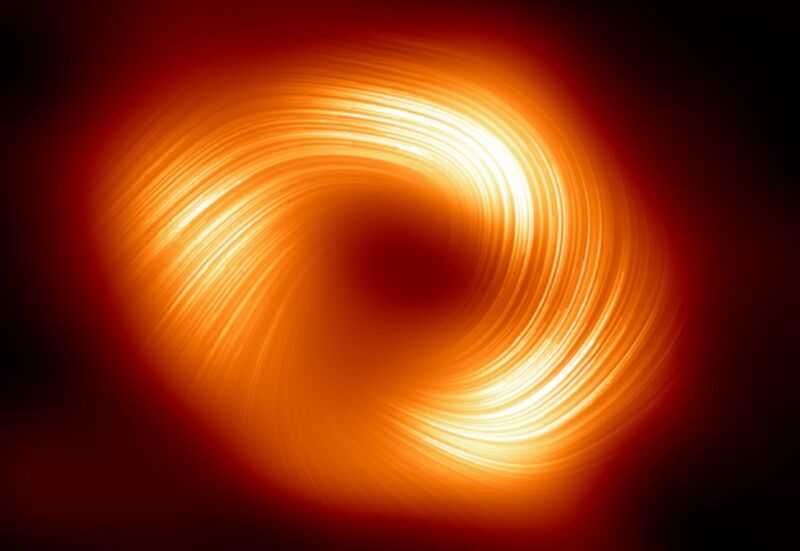
EHT collaboration
Physicists have believed since the 1980s that there is a supermassive black hole at the center of the Milky Way, similar to what is thought to be at the center of most spiral and elliptical galaxies. It was first dubbed Sagittarius A* (pronounced A-star), or SgrA* for short. The Event Horizon Telescope (EHT) captured the first image of SgrA* two years ago. Now the collaboration has revealed a new polarized image (above) showing the black hole's rotating magnetic fields. Technical details appear Two New Papers Published in The Astrophysical Journal Letters. The new image is similar to another EHT image of the massive supermassive black hole M87*, so it may be one shared by all black holes.
The only way to “see” a black hole is to image the shadow created by light in response to the object's powerful gravitational field. As Ars Science Editor John Timmer reported in 2019, the EHT is not a telescope in the traditional sense. Rather, it is a collection of telescopes scattered around the world. EHT is developed by interferometry, which uses light in the microwave regime of the electromagnetic spectrum captured at different locations. These recorded images are combined and processed to create an image with the resolution of a telescope similar to the size of the most distant places. Interferometry is used at facilities such as ALMA (Atacama Large Millimeter/Submillimeter Array) in northern Chile, where telescopes span 16 km of desert.
In theory, there is no upper limit to the array size, but you need very precise location and timing information at each site to determine which photons appeared at the source at the same time. You still need to collect enough photons to see anything. So atomic clocks were installed in many places, and accurate GPS measurements were built up over time. For EHT, ALMA's large collection area—selecting wavelengths where supermassive black holes are most luminous—ensures sufficient photons.
In 2019, EHT announced that The first live film was taken The black hole at the center of an elliptical galaxy, Messier 87, is located about 55 million light-years away in the constellation Virgo. This image would have been impossible a generation ago, and has been made possible by technological advances, innovative new methods, and (of course) the linking of many of the world's best radio laboratories. The image confirmed that the object at the center of M87* is indeed a black hole.
In 2021, the EHT collaboration released a new image of M87* that shows what the black hole looks like in polarized light — the signature of magnetic fields at the edge of matter — that provided new insight into how black holes suck up matter and emit powerful jets. from their centers. A few months later, EHT returned with images of the “dark heart” of the radio galaxy. Centaurus AEnables collaboration to mark the place The supermassive black hole at the center of the galaxy.
SgrA* is much smaller but much closer than M87*. Capturing an equally sharp image is a bit more challenging because SgrA* changes on time scales of minutes and hours compared to days and weeks for M87*. Physicist Matt Strassler compared earlier “Exposing a tree for a second on a windy day. Things get blurry, and it's hard to make out the true shape of what's captured in the film.”